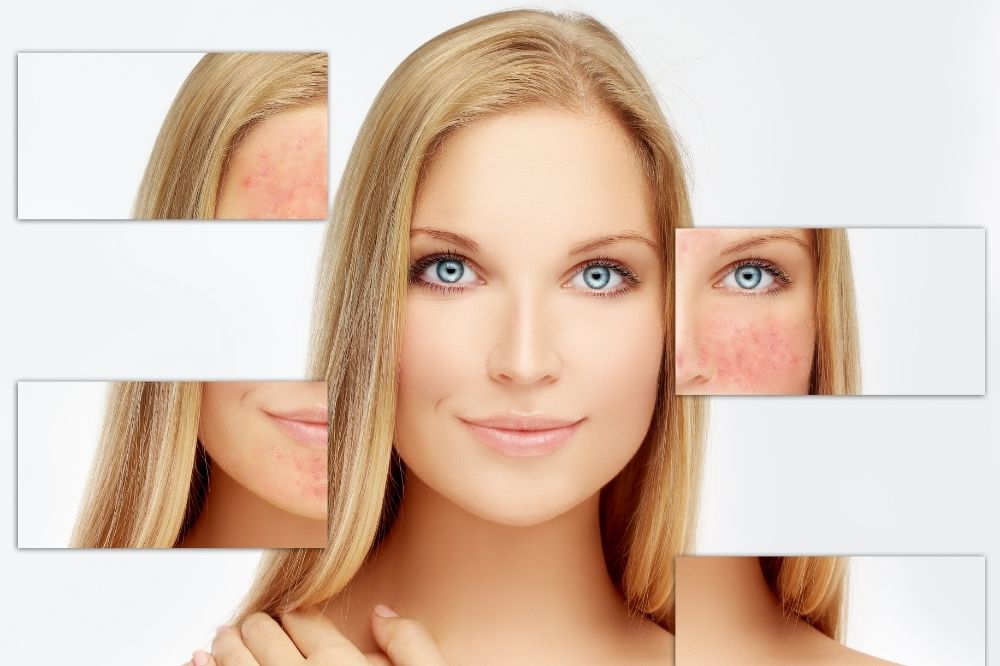What is Rosacea (Rose Disease)?
It is a chronic skin disease that especially affects the middle part of the face such as the nose, chin, forehead and cheeks, starts with flushing and burning attacks, and then causes acne, permanent redness, increase in capillaries, and an edematous appearance on the skin. It is also known as rose disease.
What Causes Rosacea?
The exact cause of rosacea is unknown. Conditions known to be associated are:
Genetic predisposition; 30-40% of people with the disease have a family history.
Infectious causes; The most accused infectious agents are Helicobacter pylori (H pylori) bacteria found in the stomach and demodex mites found on the face.
Environmental factors; ultraviolet light and temperature changes play a role in the onset or exacerbation of the disease.
Psychological state; Especially intermittent episodes of burning and redness can be affected by changes in the patient’s mood and psychological stress.
What Are the Symptoms of Rosacea?
It is mostly seen in adults between the ages of 30 and 60, with fair skin and colored eyes. Although it is more common in women, it is more severe in men.
There are four clinical stages;
1st stage: Recurrent episodes of burning and redness on the face,
2nd stage: Permanent redness in the middle of the face, formation of visible small blood vessels on the nose and cheeks,
3rd stage: The redness of the face becomes darker and permanent, and small, red bumps or inflamed pimples (unlike white or blackheads) appears on the nose, cheeks, forehead,
4th stage: Burning eyes and/or constant eye tenderness, and/or red, swollen nose (rhinophyma).
How Is Rosacea Diagnosed?
The diagnosis is often made based on clinical findings. However, biopsy may be required to distinguish it from some other diseases. There is no laboratory finding specific to rosacea.
Does Rosacea Manifest with Ocular Involvement?
Eye involvement occurs in approximately 1/3 of the patients. In 20% of the patients, only eye involvement can be seen without skin involvement. Ocular involvement is not associated with the presence and severity of skin findings. In eye involvement, findings such as blepharitis, conjunctivitis, keratitis, photophobia, watering eyes, burning eyes, chronic ocular edema, diffuse eye pain, and blurred vision can be observed.
What are the Factors that Trigger Rosacea?
- Foods and beverages (such as hot-cold drinks and foods, tea-coffee, spicy foods, bitters, pickles, chocolate, alcohol)
- Weather conditions (sunlight, hot weather, cold weather, humidity, wind)
- Psychological stress and extreme exercise
- Bath, cleaning and personal care products (Hot bath and face irritating cleaning materials, cologne, tonic, rose water, wet wipes)
- Medications (long-term use of topical corticosteroids on the face)
- Systemic conditions (premenstrual period, pregnancy, menopause, severe cough and constipation)
How Is Rosacea Treated?
Although rosacea is difficult to cure completely, it is possible to keep it under control with treatment. The most important step in treatment is to avoid factors that increase clinical symptoms.
- Protection from the sun: One of the most important factors triggering the disease is the sun. Therefore, you should be careful about sun protection throughout your life. You should use a suitable sunscreen recommended by your dermatologist at intervals of 2-4 hours, everyday. You should also wear sun-protective hat and glasses, wear appropriate clothing, and avoid exposure to the sun during peak hours.
- Topical treatment: Creams and gels are generally used in mild cases. The most commonly used are metronidazole (cream, gel, lotion), azelaic acid (cream, gel) and sodium sulfacetamide, sulfacetamide + sulfur. Other drugs are tretinoin, benzoyl peroxide, erythromycin, clindamycin, tetracycline, 5% permethrin cream, tacrolimus and pimecrolimus.
- Systemic Treatment: In severe cases, systemic treatment is applied alone or together with topical agents. The most preferred systemic agents are systemic antibiotics (minocycline, doxycycline, tetracycline, metronidazole and azithromycin) and isotretinoin, a vitamin A product.
- Laser therapy: Various laser treatments and intense pulsed light (IPL) systems can be effective, especially in the treatment of facial redness and capillary increases.




